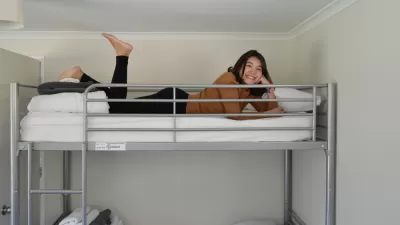Critics argue laws preventing unrelated adults from living in the same home fail to understand the modern American household.

If you’ve ever lived with a group of roommates, it’s possible that the arrangement was technically illegal in your city. As Michael Waters writes in The Atlantic, many U.S. localities have restrictions on the books that limit who can live under one roof. Yet the typical ‘nuclear family’-based household is quickly disappearing, with only 19 percent of U.S. households composed of married couples with children in 2020, down from 44 percent in 1965.
Waters reveals that “A study from last year found that 23 of the 30 largest American metro areas placed limits on the kinds of groups who could buy or rent a single-family home.” And “Though some places permit additional ‘unrelated persons’ (usually two to five) to live under the same roof, others don’t allow any at all.”
These rules, haphazardly enforced, can have serious consequences. “In 2016, the town of Wolcott, Connecticut, refused to allow a group home for people with disabilities to open. A resident of Bar Harbor, Maine, fought the development of a home for seasonal workers (last year, the resident lost the case).” The laws have even affected unmarried couples with children and, in some places, disproportionately affect multigenerational immigrant families or targeted minority groups. “In 1976, Grosse Pointe, Michigan, wielded its ban on unrelated people living together to order out a pair of men—whom press reports implied to be gay, according to [historian Kate Redburn]—from their home.”
Waters concludes, “In the midst of a housing crisis, why restrict living arrangements to any kind of family at all?” More broadly, why should family or relationships be legally defined?
FULL STORY: Where Living With Friends Is Still Technically Illegal

Maui's Vacation Rental Debate Turns Ugly
Verbal attacks, misinformation campaigns and fistfights plague a high-stakes debate to convert thousands of vacation rentals into long-term housing.

Planetizen Federal Action Tracker
A weekly monitor of how Trump’s orders and actions are impacting planners and planning in America.

In Urban Planning, AI Prompting Could be the New Design Thinking
Creativity has long been key to great urban design. What if we see AI as our new creative partner?

Pedestrian Deaths Drop, Remain Twice as High as in 2009
Fatalities declined by 4 percent in 2024, but the U.S. is still nowhere close to ‘Vision Zero.’

King County Supportive Housing Program Offers Hope for Unhoused Residents
The county is taking a ‘Housing First’ approach that prioritizes getting people into housing, then offering wraparound supportive services.

Researchers Use AI to Get Clearer Picture of US Housing
Analysts are using artificial intelligence to supercharge their research by allowing them to comb through data faster. Though these AI tools can be error prone, they save time and housing researchers are optimistic about the future.
Urban Design for Planners 1: Software Tools
This six-course series explores essential urban design concepts using open source software and equips planners with the tools they need to participate fully in the urban design process.
Planning for Universal Design
Learn the tools for implementing Universal Design in planning regulations.
planning NEXT
Appalachian Highlands Housing Partners
Mpact (founded as Rail~Volution)
City of Camden Redevelopment Agency
City of Astoria
City of Portland
City of Laramie





























